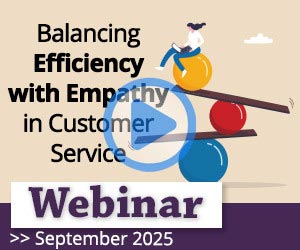Dave Salisbury discusses how contact centres can build customer listening skills and improve customer service as a result.
Where Customer Listening Goes Wrong
Consider the last time that you watched a press conference on the news. A room full of people who would claim they are professional listeners, who then report what is being said.
Yet how many times do you see questions asked with an agenda, personal opinions warping what was said into what they desired to hear? Every. Single.
Time. (*cough* Fox and CNN).A similar kind of thing goes on in the contact centre too. Advisors often assume the customer’s problem from the off and then direct the customer in the way that they desire. They rush to conclusions, without taking the time to listen properly and fully understand the problem.
This process shines a light on the problems with active listening and how active listening can be faked – which is understandable in an environment where advisors have to be fully switched on, call after call.
Where Else Does Customer Listening Go Wrong?
Of course, advisors faking active listening isn’t the only place where customer listening can go wrong. The team will often have the best of intentions, yet they face many of the following obstacles:
1. Multitasking – If your partner is watching a game of football as you communicate with them, will their listening skills be sharp? No. The same logic applies to contact centres.
When taking a call, an advisor may have to deal with navigating multiple systems or colleagues asking them if they’d like a drink or something else of that nature, which distracts them from listening.
2. Noisy Backgrounds – Whether your headsets are of low quality, the contact centre is rather crowded or you work with remote advisors who live in noisy buildings, loud backgrounds can be a real distraction.
So don’t think about removing background noise solely from the point of view of the customer, consider how a loud environment will impact an advisor’s listening skills too.
3. Strict Metrics – Many contact centres still target advisors on Average Handling Time (AHT) and if advisors are being punished on talk time, then they will start skipping through things and good listening practices will go out the window.
This is just one example of why we have got to be careful that the Key Performance Indicators (KPIs) that we are using are driving the right behaviours.
4. Poor Resourcing – If we have fewer people than we need in the contact centre, for whatever reason, advisors are often made to feel under pressure.
When this happens and we have to deal with unexpected spikes in call volume, that can again cause our listening skills to suffer.
Removing some of these barriers can be a good start to improving customer listening skills, before we move on to the next stage…
Replace Active Listening With Reflective Listening
While active listening can be faked, reflective listening cannot. Just consider the differing definitions of active and reflective listening that are presented below, in what we can call the four levels of customer listening:
- Inactive listening – This is where you are hearing words or seeing written communication, but it’s having zero impact mentally. This is mostly because your internal voices drown out the possibility for communication.
- Selective listening – Common in contact centres, selective listening is when you only listen to what confirms your own voices, opinions and biases. While others are speaking, you are already forming your response.
- Active listening – This is where you show the other person you are paying attention and engage with meaning in a reply.
- Reflective listening – As best practice, reflective listening involves paying attention to intent and content and reducing emotion. It is bidirectional as both parties are engaged in achieving mutual understanding.
From these definitions, we can see that reflective listening involves reflecting back parts of what the customer has said to demonstrate a mutual understanding.
Not only is this much harder to fake, but if we can demonstrate that we understand the customer’s problem, any subsequent show of empathy becomes much more authentic. It also makes rapport building easier.
These are big pluses, but good customer listening requires more than reflecting back what the customer has said. We must also adapt well to the flow of the conversation thereafter.
To Listen Well, We Must Also Adapt Our Communication Style
Good communicators will use reflective listening and adapt their message to the audience.
To be able to adapt their communication style, a good listener in the contact centre will:
- Be well trained by an enthusiastic team leader, who role-plays scenarios and teaches advisors to mentally prepare for each call, so they don’t start making basic assumptions.
- Probe the customer, and alter their phrasing based on whether the customer is looking to find a solution or move away from a problem.
- Look to clarify what is being said, through reflective listening, in order to achieve a mutual understanding.
However, too often those labelled as “good communicators” cannot listen reflectively as they fall into dangerous routines of assuming the customer’s problem.
Ideally, though, our continuous coaching and culture will help to build a customer service focus which cultivates an attitude and desire to help customers.
Find out how to build a customer service focus in our article: How to Achieve Excellent Customer Service Through Coaching
How Else Can We Improve Customer Listening?
The following are some launch points for improving customer listening and developing the right attitudes and desires in the contact centre:
1. Understand your desire. Know and understand that what you desire from an interaction determines its success.
2. Practise mental preparation, based upon previous situations, to make different choices. Listening is a voyage of discovery to reach a mutual understanding, but mental preparation is key to safely reaching the destination.
Prepare and practise until what currently feels alien becomes familiar. Doing so in front of a mirror is always best practice.
3. Reduce emotion. The principles of empathy and sympathy can damage an advisor’s ability to listen, if taught in the wrong way.
If the advisor feels as though they must show empathy at some point in the call, their internal voice will focus on finding the opportunity to demonstrate empathy.
The volume of internal voices can silence the ability to listen reflectively, fuelling the need to fake active listening for employment’s sake.
4. Listen as you would have others listen to you. This is an adaptation of the “Golden Rule” and remains applicable as a personal choice. How you choose to listen will determine your destiny.
5. Body language is a non-verbal communication channel that can be heard as well as seen.
How are you communicating non-verbally and how is that interfering with your written and verbal communication attempts? It’s important that advisors ask these questions of themselves.
Remember, listening remains the number-one tool you control, and its principles apply to written channels, not just the phone.
More Great Advice for Improving Customer Service Listening Skills
In addition to all of Dave’s great advice on improving customer listening skills, we also have a great video to share with you from Carolyn Blunt, a Business Development Director at FWD Training & Consultancy.
The video shows Carolyn taking us through here favourite five tips for improving listening skills.
For those of you who lack the time to listen to the reasoning behind every tip that is presented in the video, here is a quick rundown of Carolyn’s five tips.

- Beware of solution-focused thinking
- Speed is the enemy of good listening
- Uncover your secret narcissists
- Identify the chatter that you need to silence
- Practice makes perfect
To hear more from Carolyn on how to improve customer listening, read our article: Top Tips to Improve Listening Skills on the Telephone
Final Thoughts
“Most people do not listen with the intent to understand; they listen with the intent to reply.” – Stephen Covey, Author of The Seven Habits of Highly Effective People.
The problem that Covey describes here is one of the biggest that we face within the customer service industry today.
Why? Because listening is hard. Yet it’s also a choice.

As many people have pointed out, we have two ears and one mouth, so we can listen twice as often as we speak.
So embrace listening. Choose to listen reflectively, choose to reach a mutual understanding and watch your destiny change.
Good luck!
Written by: Dave Salisbury, an Operations and Customer Relations Specialist
For more from Dave Salisbury, read some of his other articles by following the links below:
- Key Performance Indicators (KPIs) Are Damaging Employee Engagement
- What “Going the Extra Mile” REALLY Means in Customer Service
- What Is the Purpose and Mission of Your Contact Centre?
Author: Dave Salisbury
Reviewed by: Jonty Pearce
Published On: 16th Sep 2020 - Last modified: 15th Dec 2025
Read more about - Skills, Carolyn Blunt, Customer Service, Dave Salisbury, Editor's Picks, Listening, Skill Development, Soft Skills, Training and Coaching









































